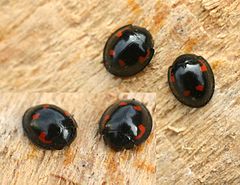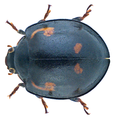Exochomus quadripustulatus
| Exochomus quadripustulatus | |
|---|---|

| |
| Adult Exochomus quadripustulatus | |
| Scientific classification | |
| Kingdom: | |
| Phylum: | |
| Class: | |
| Order: | |
| Family: | |
| Subfamily: | |
| Tribe: | |
| Genus: | |
| Species: | E. quadripustulatus
|
| Binomial name | |
| Exochomus quadripustulatus | |
| Synonyms | |
Exochomus quadripustulatus, common name pine ladybird or pine lady beetle, is a species of beetle of the family Coccinellidae.[1][2][3] The distribution range of E. quadripustulatus includes Europe, Northern Asia (excluding China), and North America.[2]
Description
[edit]Exochomus quadripustulatus can reach a length of about 4-6 millimeters. It is almost circular, convex and shining, with a flange around the base. The color is quite variable and may change with ageing. Usually elytra are black with two larger red comma-shaped spots and two smaller red round or oval spots. The color of these spots can also be orange or yellow, but completely reddish brown specimens may occur. The pine ladybird in both adult and larval stages preys aphids and scale insects, especially Diaspidiotus perniciosus. Adults overwinter.
Distribution
[edit]This species is present in most of Europe, in the eastern Palearctic realm, and in the Near East. It was first recorded in Ireland (County Armagh) in 2014.[4]
Habitat
[edit]This fairly common ladybug can be found from April to October on conifers and in areas with deciduous trees, but it can also occur elsewhere.
Ecology/Biological Control
[edit]Exochomus quadripustulatus helps with biological control in infested areas by being a candidate predator of Toumeyella parvicornis, an alien pest that infests stone pines; it has been observed to be more attracted to conspecific and heterospecific ladybugs than Cryptolaemus montrouzieri, another candidate predator, and responds to prey more quickly.[5]
Gallery
[edit]-
Larva
-
Pupa
-
Newly emerged adult
-
Adult, reddish form
References
[edit]- ^ McClarin, Jim; Moisset, Beatriz; Entz, Chuck; Quinn, Mike; Moyer, Tim; belov, v; Parker, Harsi S.; Parker, Abigail (18 September 2006) [Last updated 11 July 2017]. "Species Brumus quadripustulatus - Pine Lady Beetle". Bugguide. Iowa State University.
- ^ a b "Brumus quadripustulatus (Linnaeus, 1758)". Integrated Taxonomic Information System. doi:10.5066/F7KH0KBK. Taxonomic Serial No.: 692613.
- ^ "Pine Lady Beetle : Brumus quadripustulatus (Linnaeus 1758)". Encyclopedia of Life. National Museum of Natural History, Smithsonian Institution.
- ^ Foster, Stephen; Nelson, Brian; Anderson, Roy (December 2018). "Pine ladybird Exochomus quadripustulatus (Linnaeus) (Coccinellidae) new to Ireland". The Coleopterist. 27 (3): 114. ISSN 0965-5794. Web of Science ZOOREC:ZOOR15503017546.
- ^ Di Sora, Nicolò; Rossini, Luca; Contarini, Mario; Virla, Eduardo Gabriel; Speranza, Stefano (June 2024). "Are the ladybugs Cryptolaemus montrouzieri and Exochomus quadripustulatus (Coleoptera: Coccinellidae) candidate predators of Toumeyella parvicornis (Hemiptera: Coccidae)?". Pest Management Science. 80 (6): 2881–2891. doi:10.1002/ps.7996. ISSN 1526-498X.
External links
[edit]- "Exochomus quadripustulatus". Taxonomy Browser. National Center for Biotechnology Information. NCBI:txid115346. (This database is described in: Schoch, Conrad L; Ciufo, Stacy; Domrachev, Mikhail; Hotton, Carol L; Kannan, Sivakumar; Khovanskaya, Rogneda; Leipe, Detlef; Mcveigh, Richard; O’Neill, Kathleen; Robbertse, Barbara; Sharma, Shobha; Soussov, Vladimir; Sullivan, John P; Sun, Lu; Turner, Seán (2020). "NCBI Taxonomy: a comprehensive update on curation, resources and tools". Database. 2020. Oxford University Press. Article ID baaa062. doi:10.1093/database/baaa062. ISSN 1758-0463. PMC 7408187. PMID 32761142.)
- "Viervleklieveheersbeestje : Brumus quadripustulatus Linnaeus". Stippen.nl. Archived from the original on 2018-11-28.
- "Pine Ladybird - Exochomus quadripustulatus". NatureSpot : wildlife and wild places of Leicestershire & Rutland.
- Isidro (November 9, 2011). "Brumus quadripustulatus". Biodiversidad Online :: Fichas de Especies Identificadas :: Fichas de Coleópteros. El Árbol de la Vida. Archived from the original on 2016-03-05.
Further reading
[edit]- Vandenberg, Natalia J. (2002). "Family 93; Coccinellidae Latreille 1807". In Arnett, R.H., Jr.; Thomas, M. C.; Skelley, P. E.; Frank, J. H. (eds.). Polyphaga: Scarabaeoidea through Curculionoidea. American Beetles. Vol. 2. Boca Raton, Florida: CRC Press LLC. pp. 371–389. doi:10.1201/9781420041231. Google Books YiPNBQAAQBAJ.
{{cite book}}: CS1 maint: multiple names: editors list (link) - Arnett, Ross H. (2000). American Insects: A Handbook of the Insects of America North of Mexico. CRC Press. p. 462. Google Books DKzAmSDdLtsC.
- Kovář, Ivo (1995). "Revision of the Genera Brumus Muls. and Exochomus Redtb. (Coleoptera, Coccinellidae) of the Palaearctic Region. Part I." Acta Entomologica Musei Nationalis Pragae. 44: 5–124.
- White, Richard E. (1983). A Field Guide to the Beetles of North America. The Peterson Field Guide Series. Vol. 29. Houghton Mifflin Company. pp. 235–237. ISBN 9780395318089. Google Books 7eMQAQAAMAAJ, oD0lAQAAMAAJ. HathiTrust 000780227.
- Gordon, Robert D. (1985). "The Coccinellidae (Coleoptera) of America North of Mexico". Journal of the New York Entomological Society. 93 (1): 19, 31, 623–624, 636–638. JSTOR 25009452.






